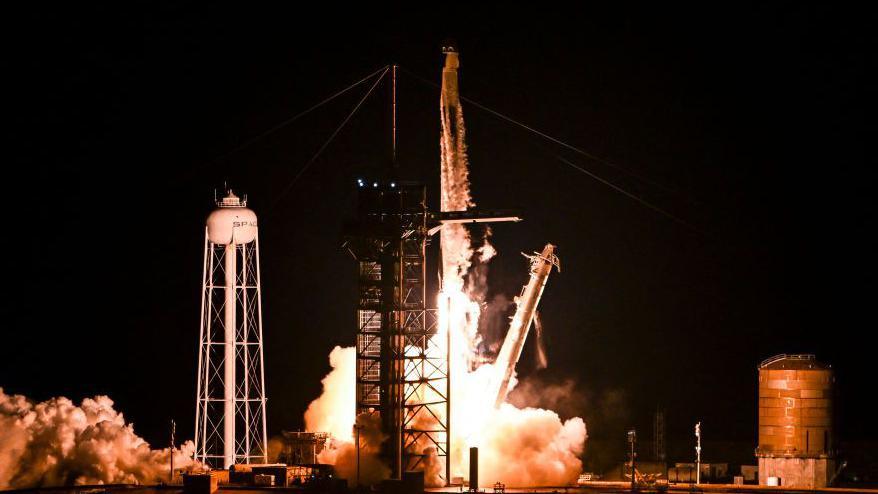Crew heads further into space than any human in 50 years

A SpaceX Falcon 9 rocket with the Crew Dragon Resilience capsule lifts off
- Published
A crew of non-professional astronauts has taken off in a SpaceX Falcon 9 rocket heading deeper into the cosmos than any humans in half a century.
The mission, called Polaris Dawn, is the first of three funded by billionaire Jared Isaacman.
He's the only person out of the team of four who has ever been into space, until now.
The spacecraft, called Resilience, set off on Tuesday, and went into an orbit of 870 miles (1,400km) above the planet.
That's more than three times farther from Earth than the International Space Station and no human has been that far since Nasa's Apollo programme ended in the 1970s.
More spectacular space stories!
- Published30 August
- Published12 July
How will the Polaris Dawn mission work?
The mission will last for roughly five days.
During this time the astronauts will pass through a region of space known as the Van Allen belt, which has high levels of radiation.
The crew will be protected by the spacecraft and their newly upgraded spacesuits.
They'll be exposed to the equivalent of three months of the radiation astronauts experience on the International Space Station, which is within acceptable limits. They'll study the effects that this has on the human body.
Jared is onboard as commander alongside his friend Scott 'Kidd' Poteet, who is a retired air force pilot, and two SpaceX engineers Anna Menon and Sarah Gillis.
The crew will spend their second day at their maximum altitude and will complete up to 40 experiments, including testing laser-based satellite communications, aiming to improve space communication speeds.
On day three of the mission, Mr Isaacman and Sarah Gillis are expected to attempt the spacewalk, which is scheduled to last two hours.
The Crew Dragon capsule lacks an airlock, so all four astronauts will be exposed to the vacuum of space for around two hours, as the two crewmates venture out, in turn, for 15 to 20 minutes each.
This will be while they are around 430 miles (700km) in orbit.
The Polaris Dawn crew...and their new spacesuits
Anna Menon, Scott Poteet, Jared Isaacman and Sarah Gillis are the crew members of Polaris Dawn
The team did more than two years of training to prepare for the mission.
They're dressed in newly developed SpaceX suits (EVA) with displays that provide information about the suits as they're being used, helmet cameras and advanced joint mobility systems.
The suits are said to be comfortable and flexible enough to be worn during launch and landing so no other suits are needed.
In an interview Ms Gillis said that it was a necessary part of Space X’s plans to send people to other worlds.
Sarah said: “So far only countries have been able to perform a spacewalk. Space X has huge ambitions to get to Mars and make life multiplanetary.
"In order to get there, we need to start somewhere. And the first step is testing out the first iteration of the EVA spacesuit so that we can make spacewalks and future suit designs even better.”
What's next for the Polaris missions?
Polaris Dawn is the first of three missions under the Polaris programme.
The final mission is aiming to be the first crewed flight of SpaceX's Starship prototype.
This is the rocket the company says is the key to people living on Mars in the future.
More 'out of this world' stories
- Published15 April 2023
- Published1 February
- Published20 September 2022
